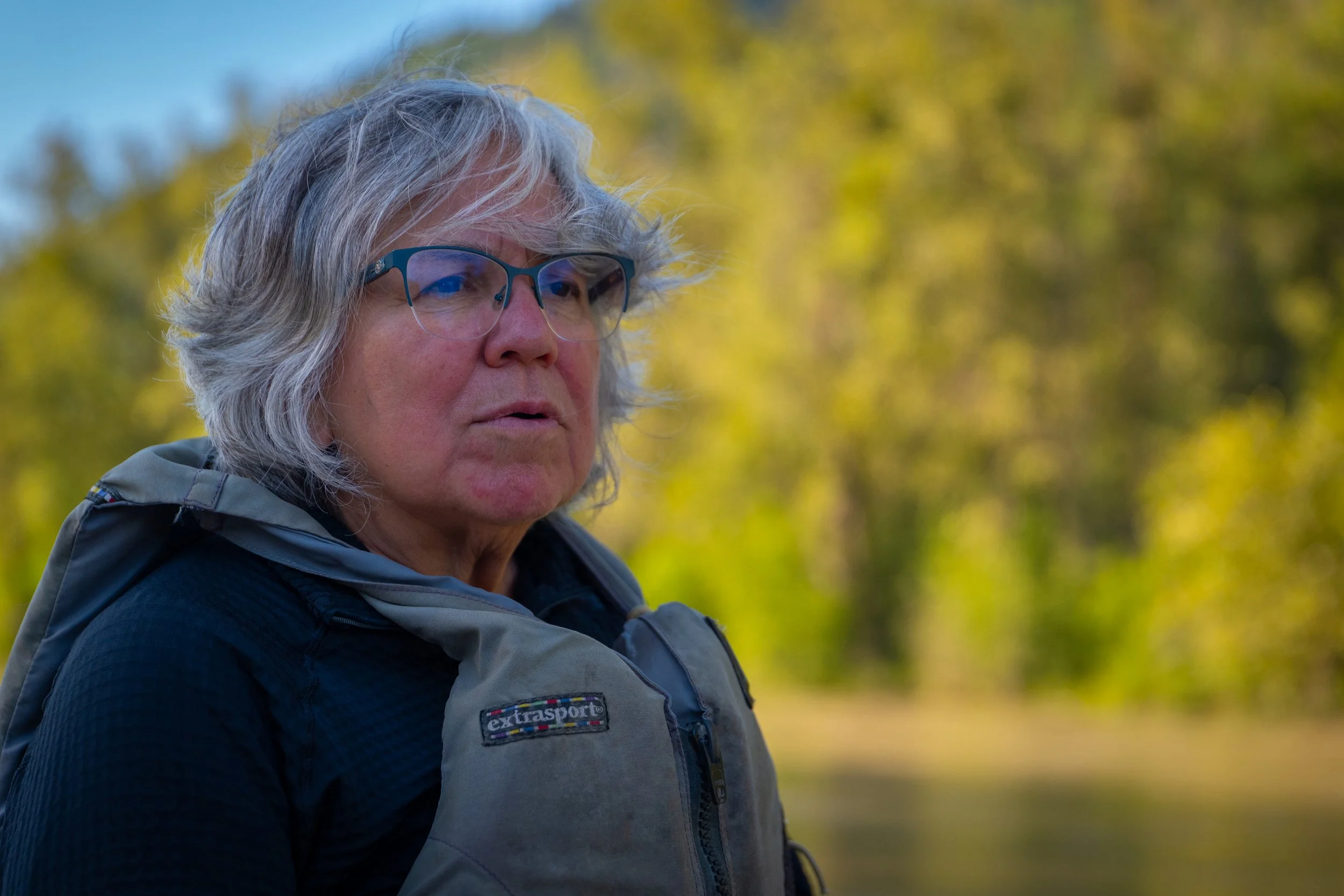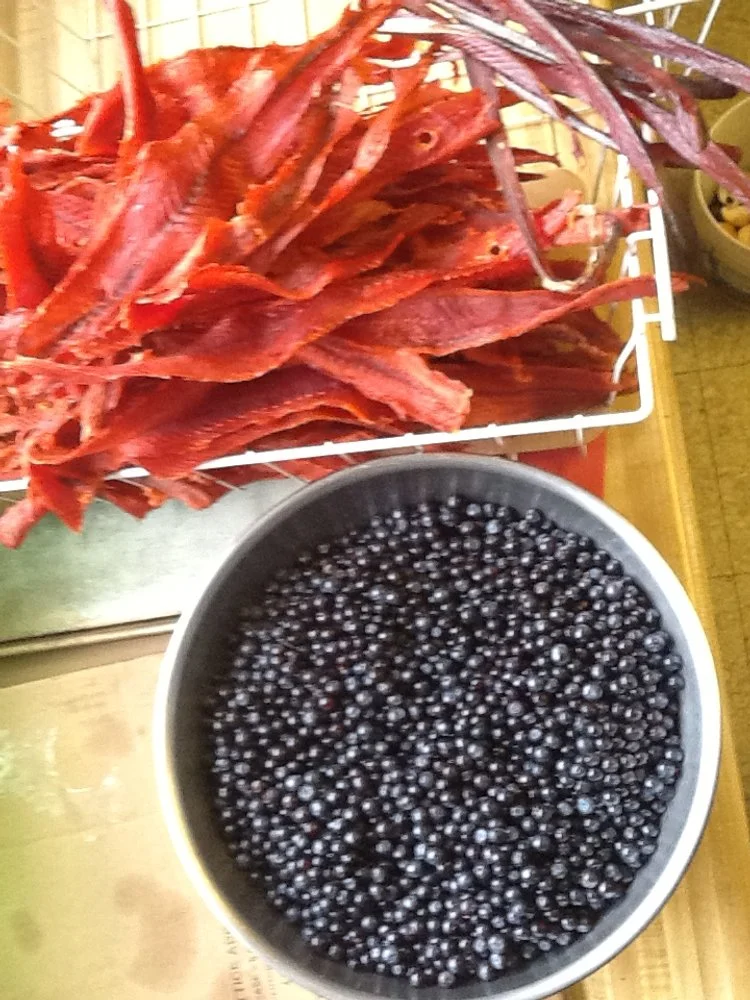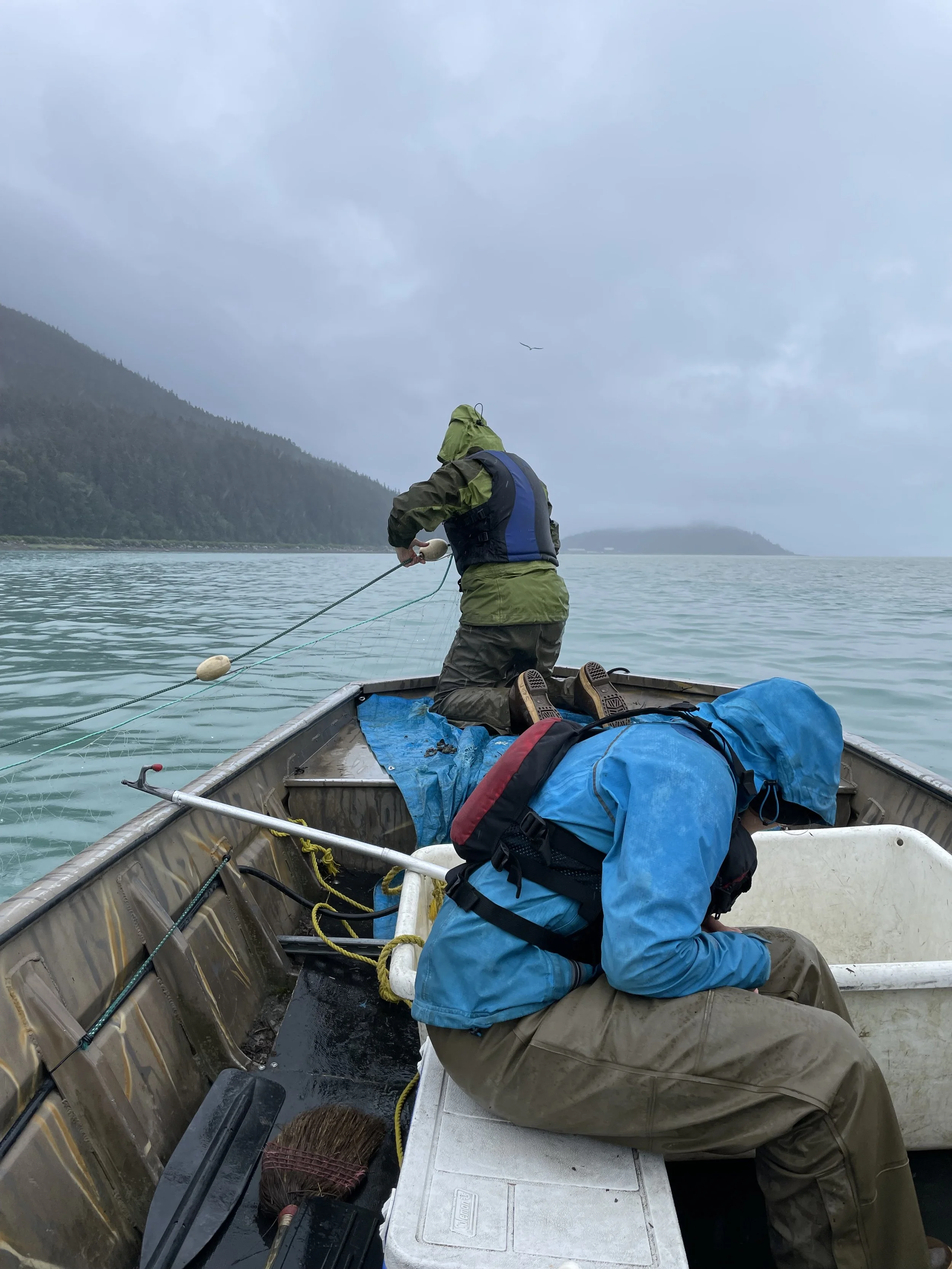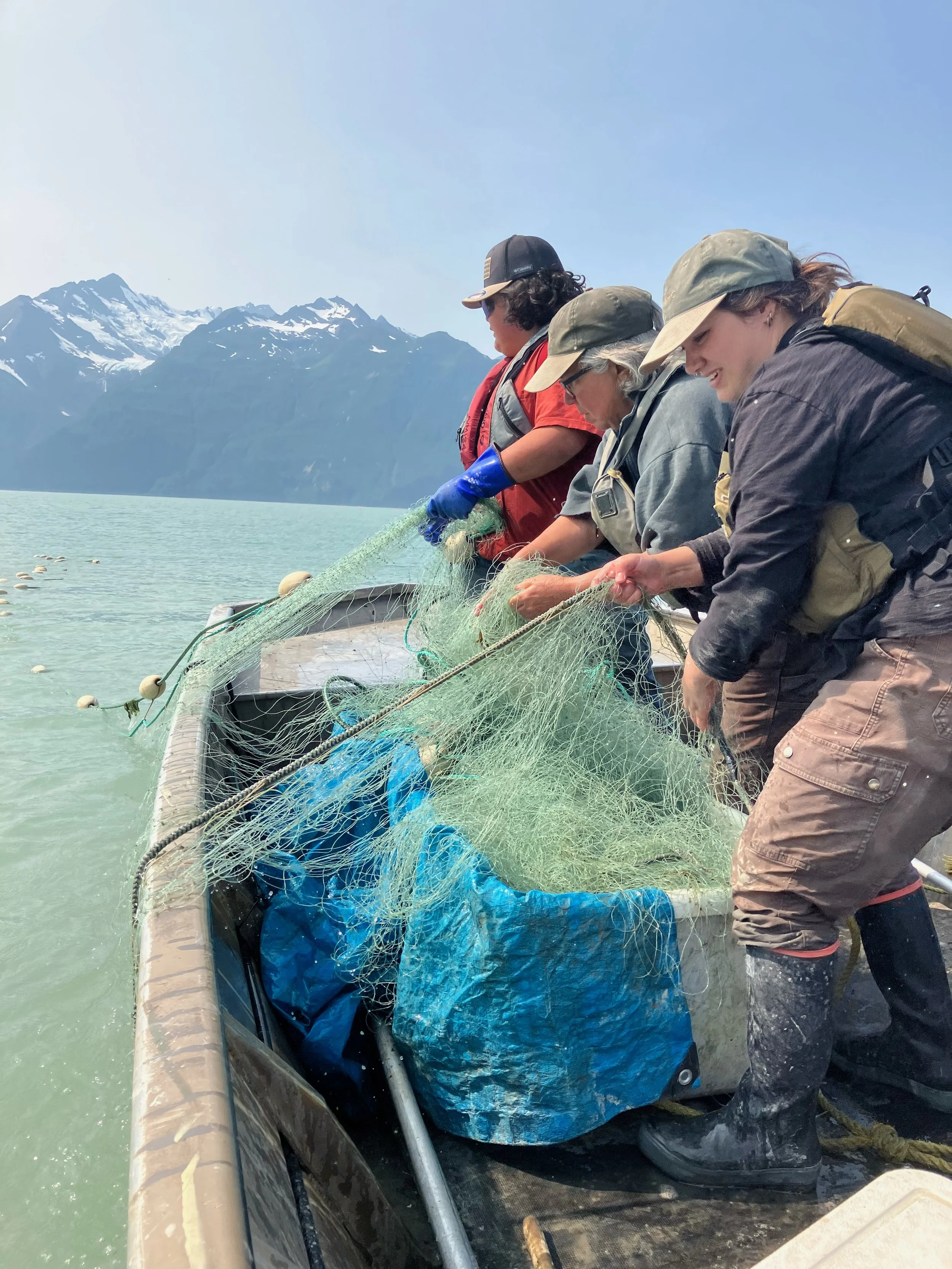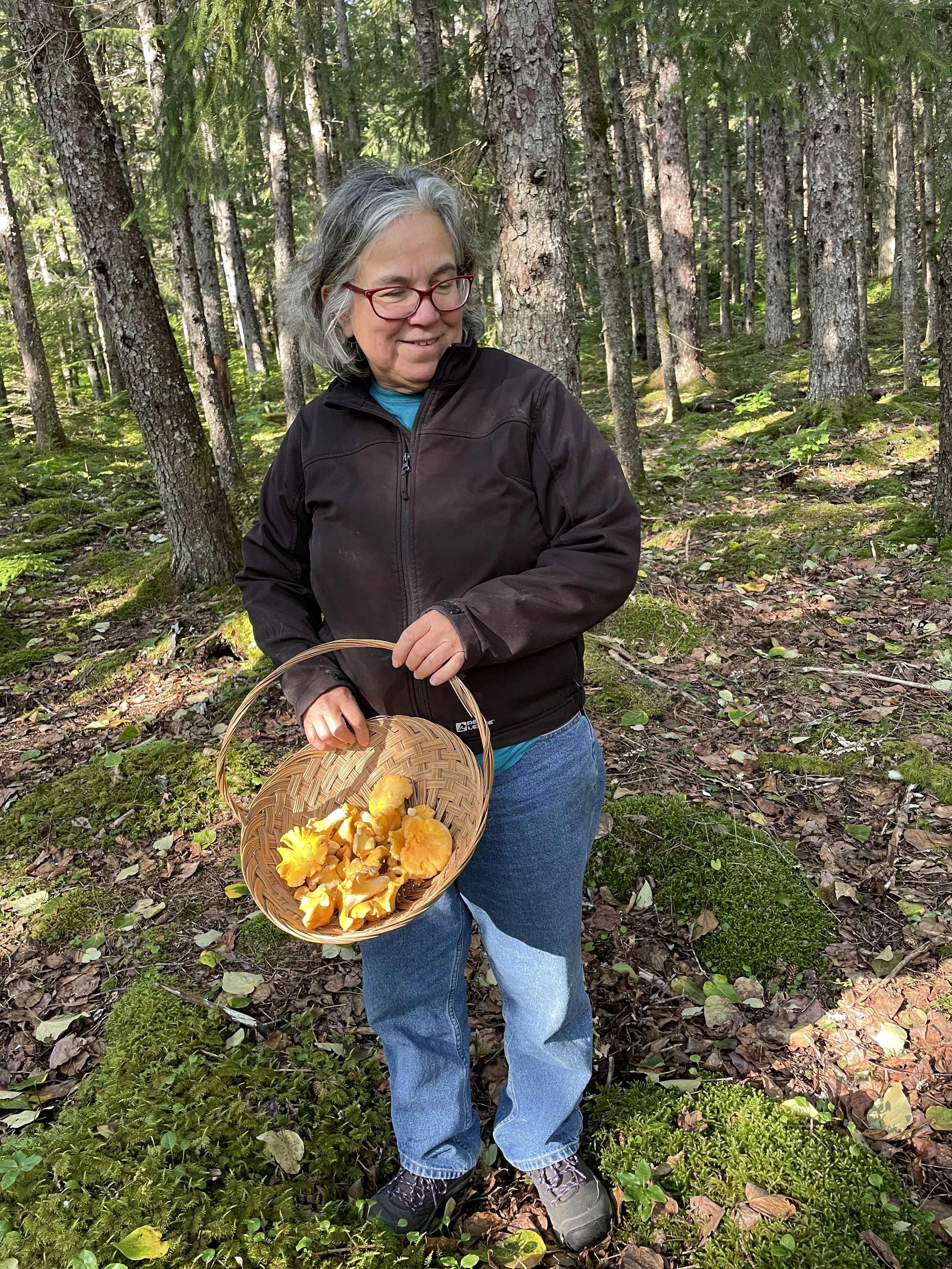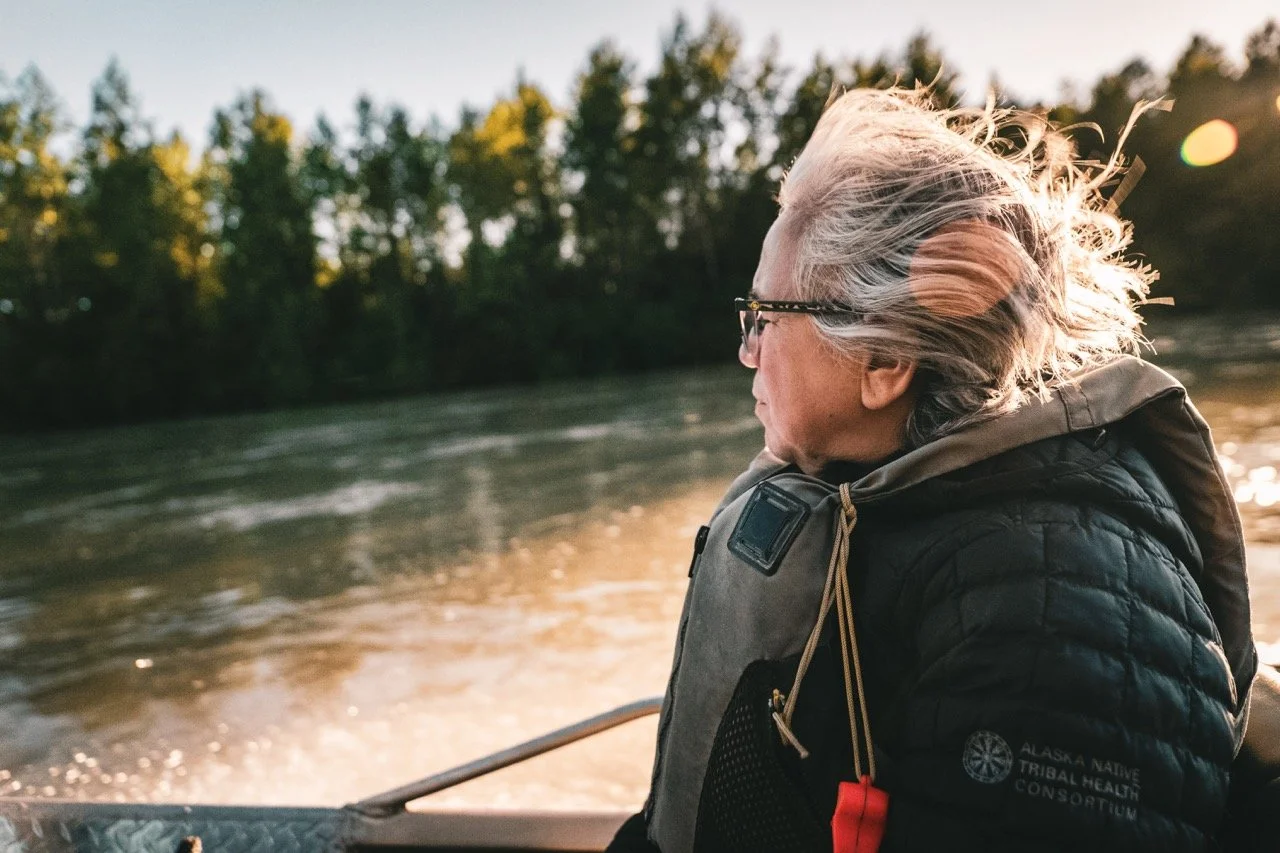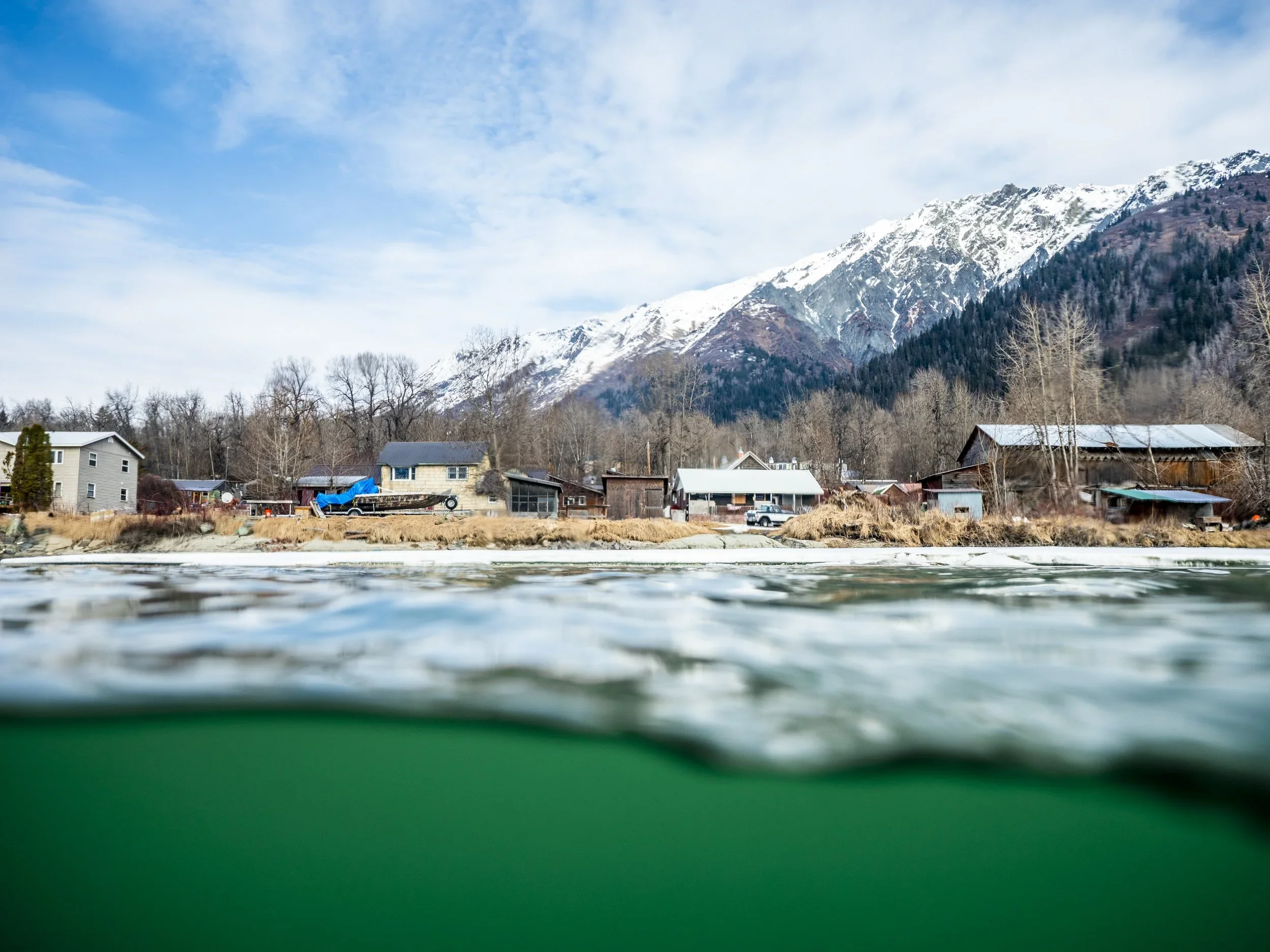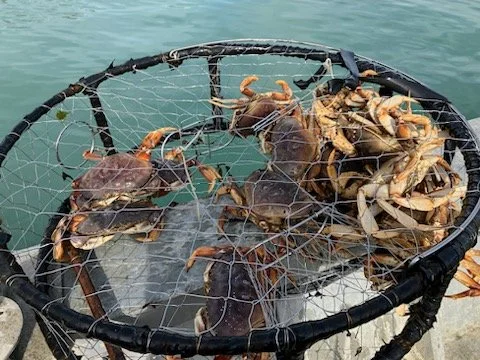Kimberly Strong
“I'm Kimberley Strong, the vice president of the Chilkat Indian Village of Klukwan. And I've lived in the Chilkat Valley most of my life. I was born in Skagway, reared in Haines and Klukwan. As a child my siblings and I spent our summers in Klukwan with our grandmother, putting up fish and gathering berries. From a very young age maybe 4 & 5 years old, my sister and I got to hang the dry fish strips for our grandmother. Instilling the importance of caring for our Salmon as well as learning the most traditional form of preserving the fish that has been tought the same way for centuries.
There's so many family memories of growing up here in Klukwan.
A lot of it has to do with harvesting, going out and picking blueberries, drying and smoking fish in the summer. Learning how, where and when to harvest the natural foods that grow around us. The blueberries, the cranberries, the fiddlehead ferns in the spring. All of the different things that you can collect. The rose hips and my goodness the hooligan oil/greece.
People collect the fireweed and make fireweed jelly, fireweed honey. The list of harvesting possibilities just goes on.
That was the way we grew up. Everybody had work to do. Everybody shared in the bounty of that work.
—Kimberley Strong, vice president, Chilkat Indian Village
“I am most proud of learning how to cut and process our dryfish.
We gut the salmon and take the back bone out without cutting through skin at the back bone, we call that book style. In the book stage of the process the fish is hung over the pole to start the drying process. Once the skin is dry, we’d open the bellies up by slicing the belly bones as close to the bone as possible leaving it attached on the edge of the belly, allowing it to flap open. We call that cut newspaper style, I guess because then it can all fold back up like a newspaper?
When I started processing dried sockeye by myself, ( that my maternal uncle caught for me) I was hanging the book style fish up in any direction. He came in and he was flipping them around to all face the same direction, up river.
And I asked, ‘What difference does it make, Uncle?’
And he said ‘It makes a big difference. You're feeding the spirit of the salmon, when you have the head end facing upriver. And then when you take the fish down and you cut the strips for drying out of it, you have it facing downriver and you flip it so the meat is out. Once you take those strips out of it, you turn it around and let the spirit of the fish drift down as if it had spawned and is now going back out.
It is important to feed the spirit of the salmon as it goes upriver. It feeds us. It keeps us nourished. And so having that respect for the salmon in its spirit is one of my fondest lessons in leading respect for the food that has sustained our family for generations.
—Kimberley Strong, vice president, Chilkat Indian Village
“My brothers have a fantastic story of climbing the mountain situated behind us.
We call it Klukwan Mountain. It's the Takshanuk Range. They would climb up to the top with our grandmother, Jennie Warren. She would 2-3 carry 5 gallon Folger cans, which were square back then to put their mountain blueberries in.
She'd prepared them all a lunch to eat up there.
They'd pick mountain blueberries all day and then she would carry the cans down and keep prodding the brothers to keep up with her as they climbed back down with the berries.
She was a very strong, strong woman.”
—Kimberley Strong, vice president, Chilkat Indian Village
“Food security, to me, is one of the most vital things that we have in the Chilkat Valley. It’s something that you don't have in other places.
That’s the fight. In my mind. This river feeds us and has fed our tribe for thousands of years, it has all five species of salmon. And it also has steelhead trout and cutthroat throat, and hooligan.
Hooligan greece is what we as Jilkaat Kwaan (Chilkat People) are known for the ‘grease trail’ (the trail Tlingit people followed for generations into the interior to trade hooligan grease.) My grandmother traveled all the way to the Copper River to trade with the interior natives, all the while carrying my then, infant uncle Albert on her back.
The bounty of food was enough for her to take far north for trading.
My thoughts wander to how we still go about harvesting the same foods. The traditional foods are so healthy for us, for instance blue blueberries are loaded with antioxidants, and the highbush cranberries have vitamin C.
There's so much food. Wild crab apples. Salmonberries. Wild currants. All of the things that you can harvest here and put up for the winter. Tlingit potatoes.”
—Kimberley Strong, vice president, Chilkat Indian Village
“Having food security for our tribal members means we can share with everybody. It makes me smile to think that when I was growing up with 11 siblings of us children to feed, our father would say, ‘Oh, sit down, join us for dinner, we have plenty, we will just add one more cup of water to the stew.’
That’s the mentality. That you share what you have. And growing up in Klukwan, children know that they don't have to go hungry. Children across our country should not know hunger, they should know not to mess with important biodiverse areas that create a world class food basket. This begs the question, destroy our biodiversity with hard rock mining? We can't eat the gold or other nonessential minerals.
And people will say, ‘Well, you like the technology? Yes.
But if it kills us by taking away our food source, is that more important than food security? If we can't feed ourselves because we've ruined the land, so it no longer produces the food that's fed us for thousands of years, then what?
We can not share the foods we don't have.”
—Kimberley Strong, vice president, Chilkat Indian Village
“Our food resources are plentiful now. But if a mining disaster happens up river from us, what will happen to our food sources?
What will happen to the wildlife?
This weekend, I'm going to process black bear meat and make sausage with friends and share it with them. That sharing opportunity could go away.
Bears are coming out now to eat the fish. They're fishing in the river. If the fish aren't there, they're not going to do that. And the eagles that are perching up there and catching their fish aren't going be catching them either.
And the real hard part of it is if you do this upstream, it all goes downstream, it isn't like it gets cut off right there and, and it doesn't contaminate everything.
Gold isn't more important than being able to feed your family.”
—Kimberley Strong, vice president, Chilkat Indian Village
“If the Palmer mine gets fully developed it has a great potential of destroying food security.
Going up the Chilkat River, you can see so many different avalanches or rockslides that have come down in various places for no apparent reason. Earthquakes, too. You just don't know what Mother Nature is going to do.
A human made tailing pond has been known to fail. There's no guarantee that Mother Nature isn't going to disturb the earth.
As drilling continues into the mountainsides, don’t you wonder, how much disturbance will it take? If you hit the right spot, it's kind of like Tetris or Dominoes, where everything will fall. I don't think that we want toxins to go down that pathway.”
—Kimberley Strong, vice president, Chilkat Indian Village
“Not only do the people in Chilkat Indian Village enjoy this place, but people who come to this valley find this place to be home because of it beauty and food security.
People may have come here as loggers and the large scale logging in our area has died down, but loggers have stayed, even without the extraction industry continuing. Why are you staying here?
Because of the abundance of food? Because of the lifestyle you enjoy? Because of the natural environment?
I think you have to really ask yourself if you're living here, what is it that makes this place important to you as a home?”
—Kimberley Strong, vice president, Chilkat Indian Village
“I think people in the Chilkat Valley need to know that this hard rock mine presents a clear danger to our ecosystem.
Is the estimated 10 year mining life of that hard rock mine, really the potential loss of five species of salmon in one of the most prolific rivers in Southeast Alaska?
My friends up in Northern Alaska can’t fish for their salmon because of mining contamination. Do we want to take a chance of that happening here?
If Mother Nature can't take care of the Earth here because of what we've allowed to happen with Constantine Mining — foreign run mining companies that can come here and extract minerals for their own interests leave awake of barren land behind — I really think it should be against the law. This is not the home that they destroy.
But I think if you come here and you live here, you want to make it your home because of the abundance of food and the beauty and the ability to survive off the land — what is it that you actually need?
What are your values?”
—Kimberley Strong, vice president, Chilkat Indian Village
“Because we’re Klukwan, the village that has always been, we have a bit of a reputation. And now with our heritage center having the whale house pieces in it, the frog house, and the clan house rooms that we have in there rival other ancient ruins.
Machu Picchu is 400 years old.
Some of those clan pieces in our heritage center are older than that. And the value of people coming and sharing our culture, and sharing their culture with us, is something that we appreciate.
There’s a lot of value in us being able to share our culture with others and recognize the sustainability of our community. Our eternal village. We've always been, and we hope we'll always be.”
—Kimberley Strong, President, Chilkat Indian Village
“I think that the value of Chilkat Forever coming out now is a recognition that we are at a real breaking point.
Constantine Mining Company, North American Pacific mining — they can spend millions of dollars on public relations. And they may make us feel, as people living here, that it will create jobs. And I think we should ask and know — does it really? And does that mean we'll have a big influx of people coming into Haines, into the Chilkat Valley? How important is it to create an economic engine and have that boom and bust society that has been created in our valley?
Sustainability makes a difference to me. What is sustainable after we're done with the mine? How are we going to be able to sustain the mining infrastructure?
Are we creating a non sustainable community?
We can live here without a mine. We've proven that for thousands of years.
How do we make our population self-sustainable?
I think by using the natural elements in it, by using the salmon that come up the river. That feed the Earth and feed the eagles, and feed the bears, and feed our people.”
—Kimberley Strong, President, Chilkat Indian Village
“I'm really excited about the Chilkat Forever campaign.
It's a group of people who are concerned about a sustainable way of life, not only for the Indigenous people of the area — my people, the people who have lived here for thousands of years — but for the way of life for everybody.
It's putting a louder message out there that we have a real concern about the Constantine Palmer project. That there are real, apparent dangers that are coming from this project.
And I think that the Chilkat Forever campaign — we're really trying to be as positive as we can be about how we're approaching this issue.
We’re not saying all mining is bad. But we do need to recognize that this hard rock acid mine is a very much a problem for us.
We need to know how the mining industry works, and how they get around what we find very near and dear to us, the survival of our people.
And that's what's in danger. The survival of the people of the Chilkat Valley.”
—Kimberley Strong, President, Chilkat Indian Village


